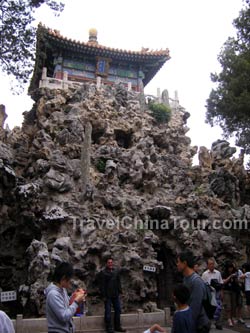The Wumen (Meridian Gate) is the south entrance to the Forbidden Palace. It was first built in 1420, during the 18th year of emperor Yongle's reign. There are 5 towers surrounding Wumen known as the Wufenglou, or the "Five Phoenix Towers". During the Ming and Qing Dynasties, grand ceremonies such as dispatching generals to war, celebrating victories, and announcing the new calendar year takes place here.
The Wumen has 5 openings - 3 on its facades, and 2 on the sides. There were specific rules for using these entrances during ancient times. The central opening was the emperor's exclusive privilege. his empress was allowed to go through the central entrance once on her wedding day, and the 3 finalists of the imperial examinations were also permitted to enter through this entrance. High ranking officials entered through the east side entrance, and princes and royal family entered the west entrance. Civil officials used the far east side gate, and military officials used the far west side gate.
Forbidden City Inner Court
The core structure of the Inner Court is the Qianqinggong. This building is build just like Taihedian, but it is a smaller version, and deemed inferior to the Taihedian. Everything in Qianqinggong is smaller than Taihedian. It stands 20 meters tall, and was built on a white marble terrace. This was the hall where all of the Ming Dynasty Emperors and two of the Qing Dynasty emperors lived and handled daily affairs.
Emperor Yongzheng of the Qing Dynasty was the first emperor to move his living quarters to Yangxindian (Hall of Mental Cultivation), and Qianqinggong was then used as an audience chamber where ceremonies were held. Foreign ambassadors were received here, and imperial banquets were also held here on special occasions such as Chinese new year, lantern festival, dragon boat festival, and the emperor's birthday. When an emperor passed away, his coffin was placed here for several days for memorial ceremonies.
In the center of Qianqinggong is the imperial throne and table covered with gold and inlaid with red and green gems. Over the throne hangs a large plaque engraved with 4 chinese characters written by Emperor Shunzhi. Since the reign of Emperor Yonzheng, the name of each crown prince was placed in a box placed behind the plaque. The emperor wrote the name of his successor on two duplicate documents. A copy was placed in a box, and placed behind the plaque, and another copy was held by the emperor. After the passing the the emperor, the box was opened and the name on both pieces of documents must match for the next emperor to be crowned.
The Jiaotaidian sits between the Qianqinggong and Kunninggong. In the center of this hall is the throne of the empress. This is the place where the empress received formal greetings from the other concubines, princesses. Kunninggong is the last major palace of the Inner Court. It is the only example of Manchurian architecture in the forbidden city, and was the residential palace of the empress during the Ming and Qing Dynasties.
The Forbidden City Imperial Garden
Located northernmost of the Forbidden Palace is the Imperial Garden. It is 130 meters long and 90 meters wide. The Qin'andian (Hall of Imperial Peace) is the central building of the Imperial Garden. In front of this Hall is a 400 year
old pine tree known as the Consort Pine, and it is a symbol
of the harmony between the emperor and the empress.

Beijing Imperial Palace - 1
Beijing Imperial Palace - 2
Beijing Imperial Palace - 3
Related Forbidden City Travel Guides:
|